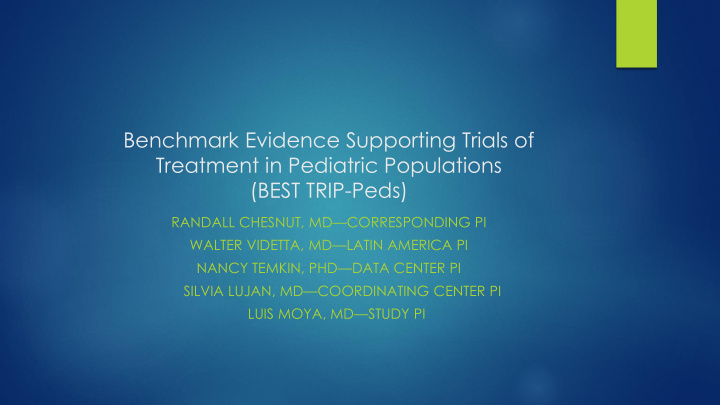



Benchmark Evidence Supporting Trials of Treatment in Pediatric Populations (BEST TRIP-Peds) RANDALL CHESNUT, MD — CORRESPONDING PI WALTER VIDETTA, MD — LATIN AMERICA PI NANCY TEMKIN, PHD — DATA CENTER PI SILVIA LUJAN, MD — COORDINATING CENTER PI LUIS MOYA, MD — STUDY PI
Structure Phase III multi-center randomized clinical trial using a 2 group parallel design
Purpose To test the effect on outcomes of management of severe TBI in children ages 1-12 guided by information from ICP monitors vs. management using a protocol that uses imaging and clinical exams to guide treatment. To determine if management based on monitoring ICP reduces complications, decreases brain-specific treatments and decreases ICU length of stay.
Study Status NINDS U01 application to be submitted in February, 2018
Protocol Inclusion /exclusion criteria Inclusion Criteria Admission to study hospital within 24 hours of injury Closed head trauma Glasgow Coma Scale score (GCS) < 8 on admission or within first 48 hours after injury (modified GCS for children under 2) Age 1 to 12 years Randomized: within 24 hours of injury [for patients with GCS < 8 on admission] or within 24 hours of deterioration [patients deteriorating to GCS < 8 within 48 hours of injury] Exclusion Criteria GCS of 3 with bilateral fixed and dilated pupils Injury intentionally inflicted by a family member or caregiver. No consent
Protocol ICP group management Based on BTF pediatric guidelines (revised to take newer results into account, e.g. ADAPT)
Protocol Imaging and clinical exam management Based on adult protocol developed by a consensus method for the current observational study. Revised for children by Dr. Moya with input from others
Protocol Finalization Meeting in the first few months of funding to revise the protocol for both arms. Consensus process similar to that used to develop the adult protocol currently being tested. Most of the participants, not all, will be from study sites
International aspects Advantages Enthusiastic colleagues, happy to participate in an effort that may change practice, appreciative of respect shown for their expertise Dedicated, resourceful staff Excellent basic ICU care Willingness to randomize
International aspects Advantages Data quality was good (with initial close oversight and frequent boosters) Sites without competing studies Capitated funding was acceptable
International aspects Advantages Lower cost Funding for a NINDS-quality trial was easy to get through Fogarty International Center
International aspects Disadvantages First participation in research for most site PIs Had to get FWA for ethics committees, had to teach about informed consent, interrater reliability, exactly following instructions, ... Need for much training and oversight Monitoring/retraining visits every 2-3 patients initially; Spanish-speaking resident sent to every site to train on how the study wanted the monitors placed and used
International aspects Disadvantages Language barrier Misunderstandings Translation both ways Simultaneous translation for all-team meetings Protocols, consent forms, letters of support Indigenous languages
International aspects Disadvantages Cultural issues Importance of personal relationships ‘Si pero no’ Timeliness, speed CTs broken for months Running out of medications Long turnaround from colleagues, sites Timed neuropsych tests
International aspects Disadvantages Cultural issues Families pay for medication, CTs Paying participants=coercion Not everyone has a phone — or an address Trails, not paved roads Political unrest
International aspects Disadvantages Fiscal Issues Fogarty $500,000 annual max NINDS 18-20% across-the-board cut Paying sites Wire transfers Lost Taking weeks Argentina 20% tax on money leaving the country
International aspects Disadvantages Government issues No distribution network for catheters Customs delays, fees Changing health landscape 4 Ministers of Health in 1 year SOAT
Opportunities for InTBIR Companion trial in high income countries Replication of CER studies in different environment
Obstacles for InTBIR Unclear how regular reviewers/funders will view studies in middle income countries Steep learning curve
Thank you Questions?
Recommend
More recommend